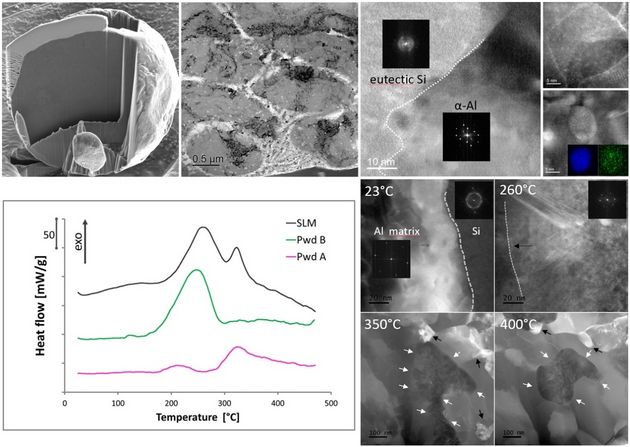Improving the mechanical properties of 3D printed metal parts
In situ TEM helps to understand the microstructural changes in AlSi10Mg during 3D printing and post processing
Selective laser melting (SLM) is an additive manufacturing technique used to create unique products for the medical technique, automotive-, aeronautic- and space industry. AlSi10Mg alloy is widely used for this technique because of its low weight, corrosion resistance, good thermal properties, specific strength, and flexible post processing capabilities. The mechanical properties of 3D printed parts show better values compared to parts that are made using traditional casting of metal. But these values decrease after conventional heat treatment. In this research, scientists from Graz Centre for Electron Microscopy, Austria, tried to understand the fundamental mechanisms responsible for the drop in mechanical properties after heat treatment.
Albu, Mihaela et al. “Microstructure evolution during in-situ heating of AlSi10Mg alloy powders and additive manufactured parts” Additive Manufacturing Volume 36, December 2020, 101605
This work provides the first correlative in-situ heating multiscale analysis of the powder and the additive produced AlSi10Mg alloy, allowing a unique insight into material transitions at the micro-and nanoscale. The researchers showed that microstructural changes like crystallization of eventually present amorphous phases and the evolution of Si nanoparticles evenly dispersed in the Al-matrix are the most important factors that contribute to the enhancement or decrease of the mechanical properties.
Benefits of in situ STEM
In-situ heating experiments in scanning transmission electron microscopes (STEM) enable immediate information about the structural, morphological and chemical changes and are thus helpful for the selection of various post-processing strategies.
The DENSsolutions Wildfire H +DT system enabled the fast heating and cooling that allowed to perform nanoscale crystallographic and chemical analyses at certain temperatures that corresponded to the exothermic peaks in DSC measurements and to the in-situ XRD measurements.
Original article by Mihaela Albu, Robert Krisper, Judith Lammer, Gerald Kothleitner, Jacopo Fiocchi and Paola Bassani



